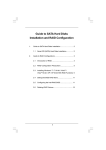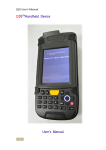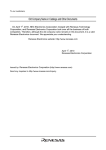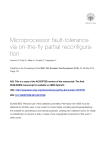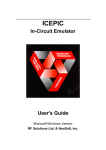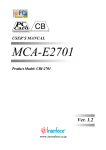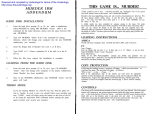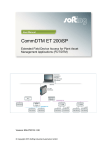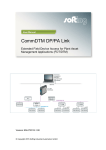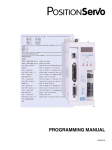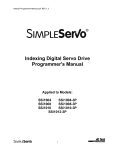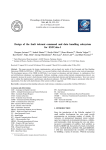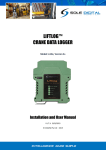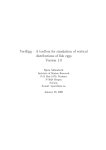Download Minimalist Fault Masking, Detection and Recovery Techniques for
Transcript
Minimalist Fault Masking, Detection and Recovery Techniques for Mitigating Single Event Effects in Spaceborne Microcontrollers UCLA Computer Science Department Technical Report TR-980025 D. W. Caldwell* , D. A. Rennels* University of California, Los Angeles, CA 90024 [email protected], [email protected] Abstract This paper presents a design approach for implementing fault-tolerant embedded computing nodes in spacecraft using non-hardened, commodity microcontrollers. The approach uses faulttolerance to address high rate transient errors and occasional latch ups that are expected of such devices in the space radiation environment. A key constraint is to minimize the amount of external logic needed to support fault-tolerance so that the primary advantage of microcontrollers, high functional density, can be maintained. Low-cost approaches which leverage features of existing commercial microcontrollers are discussed. A built-in, high-speed serial port is used for voting among redundant devices and a novel wire-OR output voting scheme exploits the bidirectional controls of I/O pins. A fault-tolerant node architecture is presented, and the effectiveness of the faulttolerance techniques is discussed. A testbed is being constructed to verify the described techniques, using triplicated microcontrollers to control a 3-axis set of rate gyros, thereby providing a realistic application example. 1. Introduction 1.1 Microcontrollers in Space Microcontrollers are highly integrated computer systems on a chip: a processor and various support functions such as program memory, scratchpad RAM, discrete I/O, A/D converters, serial ports, and counter/timers. [1,2] These very inexpensive commodity devices have not been widely used in space because of their low radiation tolerance, in part due to manufacturing processes which use mixed semiconductor fabrication techniques. There are two broad classes of problems caused by the radiation environment in space. The first of these, the total ionizing dose which causes performance degradation and ultimate failure, may be mitigated for non-hardened parts by screening and shielding; this problem is not addressed herein. The second class is due to the passage of is a single, highly-energetic charged particle through a semiconductor. These “single event effects” (SEE) have many manifestations; the most common are single event upsets (SEU) which are transient bit-flips and single event latchups (SEL) which stimulate parasitic circuits within a CMOS device causing * Both authors are also employed by the Jet Propulsion Laboratory, Pasadena, CA in the Avionics Systems and Technologies Division. UCLA Computer Science Department Technical Report TR-980025 ©Copyright 1998 by Douglas Caldwell and David Rennels 1 locally high, potentially destructive currents and which can only be cleared by power-cycling. Both of these types of SEE can be expected to occur frequently in non-hardened devices in space. [3,4] Two approaches can be taken to address SEE: using radiation hardened devices or using faulttolerance techniques. Rad-hard chips are difficult to develop and therefore costly; functional density must be sacrificed to the design rules of SEE-immune layout. Also, because the fabrication technologies required to implement the commercially-available on-chip functions such as EPROM program memory and A/D converters are generally incompatible with rad-hard processes, such functions are moved off-chip. Fault-tolerance techniques potentially allow a much wider choice of higher performance devices, supported by a wider range of development tools, which evolve as device families and thus incorporate the latest software development paradigms. 1.2 Fault-Tolerance Requirements The search within the aerospace industry to dramatically reduce the cost of high-performance spacecraft makes the use of non-hardened, commercial microcontrollers extremely attractive. As it is not cost-effective to modify these devices, fault-tolerance is the only option available to mitigate SEE susceptibility and make them usable. Other fault-tolerance requirements can viewed as an economic tradeoff, as far as the use of microcontrollers is concerned. If the surrounding circuitry becomes too complex, the design should probably be done with a microprocessor (building memory and customized interface circuitry on the outside) because most of the high functional integration of the microcontroller will be lost. The goal of this research is to provide as much fault-tolerance as possible with available devices and few augmentations – thus the notion of “minimalist” indicated by the title. This characteristic distinguishes this work from most previous research. [5] The architecture presented handles transient SEE and many permanent faults. When viewed from a spacecraft engineering perspective, the subsystem-embedded controller often has a lower permanent failure rate than its host subsystem. If single points of failure represent a small part of the overall failure rate, some can be accepted without significantly compromising the reliability of the subsystem. Similarly, it is expected that some imperfections in coverage (the probability of detection and correct recovery) can be handled by other on-board computers or ground intervention. 2. Physical Architecture Available microcontrollers provide little internal error detection, necessitating some form of replication – either duplex, triplex or hybrid for fault masking, detection and correction of errors. Since these devices typically consume a small fraction of a watt but replace more voracious devices, the overhead of multiple devices should be acceptable even in power-limited space missions. The block diagram of a spacecraft functional element (e.g., an IMU) containing a fault-tolerant group of microcontrollers (also interchangeably called “processors” hereafter) is shown in Figure 1. At the top of the figure, the system to which the functional element is attached is shown as just a source of power and communications. The I/O of multiple processors are combined and protected by I/O isolation; the external conflict resolution circuit may reset or power-cycle the devices. During normal operation, one microcontroller is the Master of the system, while the others provide redundant computation and voting opinions as Checkers. The Master and Checkers are loosely UCLA Computer Science Department Technical Report TR-980025 ©Copyright 1998 by Douglas Caldwell and David Rennels 2 synchronized and execute identical application programs, periodically calling support functions which implement the fault-tolerance features. During initialization and as part of some faultrecovery operations, a device is Offline. Although the application code executes identically on Master and Checkers, the fault-tolerance support functions are necessarily different, with the Master coordinating fault-tolerance among the one or more Checkers. The Master might be considered to be the microcontroller of the system while Checkers determine the validity of its computations. If a microcontroller disagrees with its peers, it can be commanded Offline and brought back as a Checker if it can be successfully restarted. Devices are not statically assigned so the operating mode of each device is fluid. System Communications System Power System Interface Boundary Systems Communications Buffers & Other Support Circuits Node Power Control to Other Loads Fault Containment Region Common I/O Isolation Functions µC Power Control External Conflict Resolution Vcc RESET Processor 1 I/O Isolation I/O Isolation Vcc RESET Processor 2 I/O Isolation I/O Isolation Vcc RESET Processor n I/O Isolation I/O Isolation Check Channels Normal I/O Channels Common I/O Isolation Functions Node-Specific MicrocontrollerManaged Functions Figure 1. Physical Architecture. Most of the I/O of the multiple processors is bussed together − corresponding pins are connected to a common circuit node through isolation elements (resistors); only the signals governing the external conflict resolution are unique to each processor. This approach simplifies interconnection UCLA Computer Science Department Technical Report TR-980025 ©Copyright 1998 by Douglas Caldwell and David Rennels 3 and makes the architecture easily extensible. Some of the microcontroller I/O pins are consumed implementing the Check I/O necessary for fault-tolerance; the remainder are available to the application as Normal I/O. The Check I/O pins provide three functions supporting fault-tolerance: 1) a Master Channel for data communications between processors, 2) an Operating Mode Channel to allow each processor to broadcast one of the three operating modes, and 3) four External Resolver control signals from each microcontroller to request recovery actions. The Master Channel is the primary data path for communications between the Master and others. It is used by the software fault-tolerance functions to exchange I/O values, other internal state data, or control commands. In the prototyped minimalist approach, only two pins are used for the Master Channel; it is implemented using the I2C serial bus protocol which was designed for chip-to-chip interfacing and is available as a hardware peripheral block in the chosen microcontroller. Each microcontroller generates a two-bit quasi-static Operating Mode signal indicating to its peers its level of participation in the system. The definition of these bits is shown in Table 1. Table 1. Operating Mode Definition. MASTER 0 CHECKER 0 0 1 1 1 0 1 Indicated Status Offline: off, resetting, initializing, or standing-by. Checker. Master. Intermediate metastable state between Checker and Master. The external conflict resolution block (or simply Resolver) shown in Figure 1 serves as a hard core recovery unit. When normal communications and recovery techniques using the Master Channel fail, this element provides an independent means for establishing a valid configuration. The functional interface of the Resolver is shown in Figure 2. { Action Request, Device Select } 4 { Power ISOFF } 1 { Action Request, Device Select } 4 { Power ISOFF } 1 { Action Request, Device Select } 4 { Power ISOFF } 1 2 Processor 0 { RESET, ON/OFF } 2 Processor 1 { RESET, ON/OFF } 2 Processor 2 { RESET, ON/OFF } P0 Resolver P1 P2 Figure 2. External Resolver Functional Interface. UCLA Computer Science Department Technical Report TR-980025 ©Copyright 1998 by Douglas Caldwell and David Rennels 4 The Resolver can either reset or power-cycle one or more microcontrollers. Table 2 and Table 3 enumerate the control signals available to each processor. The Action Request bits indicate the state of the microcontroller and whether an action request is being made. The (0,0) state is assigned to Idle Offline since this is the state of the outputs of either an unpowered chip or of a resetting chip when its outputs are tri-stated but pulled-down externally. When active but not requesting that an action be taken, the microcontroller indicates that it is Online but not making a recovery action request. The other two patterns request restart actions. When an action is requested, the Device Select bits specify the microcontroller(s) to be acted upon. An action request by a microcontroller directed at itself is immediately taken, but action requests directed at other microcontrollers must be concurred by a peer for the requested action to be taken. The “reset self” combination of Action Request and Device Select is not required since this action can be taken by any device without the aid of the Resolver. Thus, this input combination is redefined to mean “power-cycle all.” Table 2. Resolver Action Requests. RESET# CYCLE# Requested of State or Action 0 0 Idle Offline. Unpowered or not voting. No action requested. 1 1 Idle Online. Expected to vote but no action requested. 0 1 Vote to Initiate Resetting. 1 0 Vote to Initiate Power-Cycling. Table 3. Resolver Device Selection. DevSel1 0 0 1 1 DevSel0 0 1 0 1 Soft-SCP Usage Self/All N/A N/A All (Both) TMR Usage Self/All Right Left Both Peers Finally, the Microcontroller Power Control block of Figure 1 allows the devices to be power-cycled by the Resolver and also provides some SEL mitigation functions. More details about the hardware may be found in [6,7] 3. Application Characteristics It is useful to examine the real-time processing paradigm which is typical for microcontroller applications and which will be used in the inertial measurement unit serving as the test application for the implemented prototype. Most microcontroller applications are structured around some realtime task which is executed frequently and periodically. [8] A “real-time frame” is initiated by a real-time interrupt (RTI) and will have many sub-tasks. Figure 3 show an abstraction of a typical real-time frame including the fault-tolerance processing which will be discussed herein. The user’s application code runs in both foreground and background, the latter typically handling low-level input tasks. In the prototypical application investigated, the R-T frame is 62.5 ms long, being initiated by a 16 Hz interrupt. The background task samples three rate gyros at 10.8 kHz and does so 220 times for each gyro in every frame. After data are gathered, some output results are generated; these may be outputs which will drive physical devices, telemetry data returned to a higher-level (system) application, or state data which will be used as the initial conditions of the next R-T frame. (The data-gathering process may or may not continue during this time; in the prototype, it is not − as indicated by the dashed lines.) Some amount of idle time exists in every real-time application to accommodate processing-time uncertainties. A number of fault-tolerance processes are required to support this application processing. Before outputs are generated or propagated to the next R-T frame, they are checked for validity to prevent UCLA Computer Science Department Technical Report TR-980025 ©Copyright 1998 by Douglas Caldwell and David Rennels 5 error propagation. Data may also be checked at various user-defined intermediate points to limit fault detection latency. The asynchronous detection of Single-Event Latchup (by external hardware) will result in a device being automatically power-cycled. In Figure 3, this is shown happening to the Master, which immediately results in a Master-less system and the consequent selection of a new Master by the remaining processors. The loss of any processor, such as due to a peer-commanded reset following a vote should not interrupt processing but is unavoidable in some pathological cases which result in a system restart. (Power-cycling both the Master and a Checker during the same R-T frame is for illustration only!) Finally, time at the end of the frame is reserved for communicating state data to a previously reset or power-cycled processor to rejoin the voting ensemble as an online member. One Real-Time Frame Application Foreground Tasks Process User Requests Process User Requests Check Intermediate Data Fault Tolerance Generate Frame Result Idle Change Outputs Check Output Data Check State Data Offline Processor Rejoin Application Background Tasks Power-Cycle Master Fault Tolerance Reset Checker Reselect Master = Sample Inputs RTI RTI Figure 3. Real-Time Frame Structure. 4. Fault-Tolerance Functionality Overview Figure 4 expresses system behavior in a statechart containing four primary state machines: one representing the primary system as a whole and determined by very similar state machines representing each microcontroller’s state. (There are another four state machines running asynchronously with respect to the first set which select which processor will act as Master. These are shown as single states in this figure and their operation is described later.) Initially OFF, the system transitions to a RESET state as soon as any processor is powered. Processors automatically transition from their individual PROCESSOR_RESET states to running code. Initialization codes are executed which perform self-tests, configure I/O and start the processor fault-tolerance (PFT) functions. The first PFT function is to select one of the processors as a Master. When at least two processors are online and have agreed on a Master, the user application starts running. At userspecified locations in the application code, calls are made to PFT functions which implement the fault-detection and recovery functions. Fault-detection and isolation are primarily covered by software-implemented voting algorithms. In voting events, the Master transmits a packet of data to each Checker which, being roughly synchronized and thus at the same point in the application code, expects a check-packet. Each Checker computes its own check-packet, compares the received packet with its own, and reports equality (OK) or inequality. If no errors are detected, the processors are resynchronized and the application continues. UCLA Computer Science Department Technical Report TR-980025 ©Copyright 1998 by Douglas Caldwell and David Rennels 6 If errors are found, correct data are transmitted to the disagreeing member. If a processor does not receive an expected message (identified by a timeout), it can generate an action request to restart the expected sender. If a Checker is restarted, processing continues and the Checker is resynchronized at the next rejoin point specified by the application. If a Master is restarted, the Checkers must quickly detect the corresponding change in the Operating Mode Channel, and have the highest numbered Checker take over as Master to prevent processing disruption. One reason that the Master may go Offline is that current-sensing hardware in the external power control can detect an SEL in the Master at any time and will then immediately power-cycle the Master to clear the latchup. Because the Master is the sole generator of some outputs (e.g., high-speed clocks), an output glitch will occur if the application waits until the next cooperative voting point to deal with the error. Thus, the system must identify this case, select a new Master, and the new Master must reconfigure its outputs to fill the void. If all the processors are restarted, they must revert to a system restart point in the application software. SYSTEM SYSTEM_STATE PROCESSOR_n_STATE OFF PROCESSOR_OFF RESET Processor Fault: Recover by Reset PROCESSOR_RESET any processor leaves reset INITIALIZATION recovery impossible PROCESSOR_INIT Master selected APPLICATION FAULT_DETECTION Master selected PROCESSOR_APP check_xxx() PROCESSORS_VOTING system fault no fault FAULT_RECOVERY Processor Fault: Recover by Power-Cycle any processor on system fault no fault PROCESSOR_RECOVERY recovered RESYNCHRONIZATION PROCESSOR_SYNCH SYSTEM_MASTERSHIP OPERATING_MODE Processor OK, or Processor Fault: Recover by Coercion Figure 4. System-Level Statechart. 5. I/O Isolation and Fault-Masking Although corresponding I/O pins are bussed, each microcontroller must be isolated from its peers for two reasons. SEL mitigation requires the ability to power-cycle devices; supporting non-stop operation requires being able to cycle one without cycling others. However, the bussed I/O will allow current to flow through the input protection devices of an I/O pin and thereby back-power a microcontroller. Without limiting this current, logic-level outputs may be sufficient to sustain the latchup condition. The second function of the isolation circuits is to support voting the outputs. Although the Master will ascertain from the Checkers whether its computed results are correct, it cannot be the sole generator of outputs because its output port flip-flops are susceptible to upset. UCLA Computer Science Department Technical Report TR-980025 ©Copyright 1998 by Douglas Caldwell and David Rennels 7 Instead, both the Master and its Checkers must output their versions of truth and these must be combined externally. The straightforward approach to the isolation and voting problems would be to use active isolation and digital voting circuits, but this solution consumes significant real-estate and does not allow ports to be bidirectional. One minimalist approach might be to limit I/O pin current with resistors and use these to implement an analog voter, where the majority vote drives the output above or below the midpoint voltage. However, this approach is not compatible with standard logic families. A single output fault in a three-processor system will generate a voltage which is either 1/3 or 2/3 of VCC; a single fault in a four-processor system will generate either 1/4 or 3/4 VCC. Although 2/3 or 3/4 of a standard 5V supply (even at 4.5V) is a legitimate TTL logic high, no logic family considers 1/3 or even 1/4 of VCC to be a legal low. The midpoint may be detected by a comparator, but the following paragraphs describe a more minimal implementation. 5.1 Fault-Masking Output Ports The threshold problem may be better addressed by exploiting a feature found in the I/O port structure of almost every microcontroller. Two bits are used to define a single port pin and these two bits may be used to make it difficult to inadvertently generate an active “1”; then, favoring the hard-to-generate “1” bits, the so-generated outputs from each processor are isolated with currentlimiting resistors and combined with a logical OR. For most devices, I/O pins are bidirectional and it takes two conditions to output a high level on an I/O pin; the output flip-flop must be a “1” and the I/O pin must be configured as an output. There are three other state pairs which do not result in an active high level being output. One of these states satisfies neither of the conditions for a “high”: the output flip-flop contains a “0” and the I/O pin is configured as an input. This point lies Hamming distance two away from the active-one state; if the correct output is zero, two flip-flops of one device must be incorrect to generate an active high. If an external resistor is used to weakly pull the output down when the pin is in the {output=0, direction=input} state, then the only legal high state lies two faults away from a legitimate low state. By always using this combination of bits to generate a zero, the desired property of “hard-togenerate ones” is achieved since it will then take two upsets to generate a “1”. Table 4 shows the four possible combinations; diagonal entries have a Hamming distance of two. As noted in italics, the solution does not preclude illegal outputs from a single processor; with probability 0.25, a single bit error can result in an active low output; also, and the input protection circuits of an unpowered device will sink current. In either of these cases, correct peer outputs will drag the signal to an acceptable “high” (greater than 2/3 VCC) although this is not necessarily compatible with an arbitrary logic family. These effects can be handled in one of three ways: • • • Use low-threshold input devices (e.g., the TTL-compatible inputs of the PIC microcontrollers or the HCT family, both with VIH = 2.0 V); Use diodes to prevent current from flowing into port pins (but thereby precluding bidirectional operation); Use transmission gates (analog switches) which are turned off when the microcontroller is unpowered. UCLA Computer Science Department Technical Report TR-980025 ©Copyright 1998 by Douglas Caldwell and David Rennels 8 Essentially, the two register bits of the output port redundantly encode a single output, thereby protecting it. If any of these protected outputs generates an active “one”, it determines the output value for the wire-ORed ensemble. A side-effect of the active-high dominance is that the resulting output will be high from the time that the first device outputs a high until the last device releases it. A pulse widening equal to the maximum clock skew between any two processors occurs which is significant for high-speed outputs such as clocks. Table 4. I/O Pin States for SEU-Tolerance with Active One. Output Value Tri-State Enable Bit (PIC Microcontroller Interpretation) 1 (Configure as Input) Valid State: 0. Output = hi-Z. External pull-down yields a “zero.” 0 1 Invalid State. Output = hi-Z. Fault is either incorrect I/O configuration or incorrect output bit; output is tri-state. Correct state of the voted node will be forced by other microcontrollers and the external pull-down. 0 (Configure as Output) Invalid State. Output = low-Z, logic-zero voltage. If fault is incorrect I/O configuration state, low voltage output matches desired state (helps the external pulldown). If fault is incorrect output bit, a majority is generating low-Z, logic-one voltage; a push-pull conflict exists. “Voted” node state depends on logic thresholds (high and low) of receiver. Valid State: 1. Output = low-Z, logic-one voltage. Output overrides external pull-down. (But an output-bit fault in another microcontroller results in a push-pull conflict.) 5.2 Coverage Limitations This masking technique relies on it being impossible for a single error in an output port to result in an active-high fault, thus any active high is assumed to be correct. This only protects the output port bits after an output has been generated; it does not prevent a processor from driving both output port bits to a bad state (e.g., as the result of an incorrect computation). If the correct output value is a zero but a single device decides to output a low-impedance “1”, that output will override any number of high-impedance zeroes. This common-mode failure must be addressed by the softwareimplemented fault-tolerance functions which use the Master Channel. However, single-bit errors occurring in the short window after software voting but before port output remain uncovered. Latent faults in port registers can lead to double-bit errors and these static outputs are vulnerable 100% of operating time. Periodic scrubbing can be used to detect errors but the error rate can be reduced only so far; scrubbing too frequently increases the probability of introducing a commonmode “double-bit error” (as noted previously) as a result of a single-bit error during the scrubbing computation. The additional information about correctness required for scrubbing may be stored redundantly in RAM or determined by reading the port bits directly. The latter approach requires that the output and configuration bits be independently readable, a feature which is also valuable for validation experiments to determine the likelihood of I/O port flip-flop upset. The PIC UCLA Computer Science Department Technical Report TR-980025 ©Copyright 1998 by Douglas Caldwell and David Rennels 9 microcontrollers [2] have this capability, as do the Intel 87C196Kx, Jx and CA [1]; many older parts do not. If the expected error rate after scrubbing is still too high (e.g., for safety-critical functions), hardware interlocks may be used wherein a critical function must be enabled by an independent control signal. Interlocks are particularly valuable in a self-checking pair configuration since a single-bit error will always result in ambiguity if only two devices are voted. An I/O pin on each microcontroller used as an interlock will result in the equivalent of four microcontrollers participating in the output state vote. 5.3 Uncoverable Outputs Some outputs cannot be covered by the previously-described mechanism. Consider a high-speed output peripheral block, one which might be generate a pulse-width modulated signal. The nonlockstep synchronization between processors makes it impossible to synchronize the peripherals better than the skew between instruction streams; because a single high level will override two lows, high outputs are stretched. In the case of a PWM signal, the skew between processors directly results an output error: the duty cycle is changed by the stretched “1”. In the limiting case, the skew can change not only the waveform of the signal but may render it as a D.C. level. Consider a 250 kHz square-wave output: high for 2 µs and low for 2 µs. A threeprocessor system of PIC microcontrollers running at 20 MHz (5 MIPS) with one processor (“only”) five instructions faster than the mean and one five instructions slower than it would always have one of the three clocks high and therefore the merged output would be perceived as never changing. This shortcoming may be covered by an external circuit which implements a majority voter, either digitally or using a comparator to detect transitions through the midpoint voltage (thus implementing a true analog voter rather than the described self-checking/masking analog voter). Alternatively, the signal could be generated only by the Master if the consequent lack of coverage is acceptable. This solution also places a premium on detection of the loss of the Master as will be described below. 6. Detection, Reconfiguration and Recovery Fault masking only applies to output ports. In general, faults are identified and corrected through detection, reconfiguration and recovery. The detection process begins with software voting. Following fault diagnosis, the system is reconfigured if necessary by taking the faulty device offline (isolating it from the rest of the system) and possibly selecting a new Master. The system recovers by forcing errant devices to restart. 6.1 Normal Operation During normal operation, processors are loosely synchronized so the application code running on each voting processor reaches a checkpoint function at approximately the same time. The Master manages the voting process by first passing data to the Checkers and getting responses from them. The most benign faults detected are those which occur only in the data being checked (e.g., input data) and recovery can be accomplished by passing corrected values to each processor. UCLA Computer Science Department Technical Report TR-980025 ©Copyright 1998 by Douglas Caldwell and David Rennels 10 6.1.1 Voting by Exact Match The simplest voting algorithm is to exchange data and check for equality. The Master transmits a block of data to a Checker which, being roughly synchronized and thus at the same point in the application code, has computed its own check-packet and expects one from the Master. The Checker compares the received block with its own block and reports equality (OK) or inequality. The return status is encoded such that upsets occurring between its computation by a Checker and its transmission to the Master are identifiable. (No such parity is required for Master-to-Checker transmissions because the Checker has the check data to compare; a transmission error will appear the same as a pre-transmission computation error.) Instead of passing all the data to be checked, a syndrome may be computed and checked as a surrogate for the actual data. In order to obtain sufficient coverage, the syndrome must be at least 16 bits and preferably 32. Assuming that computation is much faster than communication, more than four bytes of data should be reduced to a four-byte syndrome which may then be checked for exactness like any other data. Whether a computed syndrome or raw data are checked should be transparent to the application and thus the choice is buried in the checking function. 6.1.2 Inexact Inputs For data which are derived directly from noisy sources, an exact match is generally impossible. Data from A/D converters are intrinsically noisy. Data sampled from discrete (binary) inputs even contains noise due to voltage threshold and sampling-time differences. It is important to reach a consistent value of these independently-sampled inputs, so that the Master and Checkers can use the same values – otherwise, their computations will diverge. The simplest way to do this is analogous to exact voting: the Master passes its value to the Checkers and, if it is within an acceptable tolerance of the value they sampled, they signal agreement and use the Master’s value. Other algorithms may be desirable. Greater accuracy can be obtained for analog values by selecting the middle value as the best or by computing an average (after discarding outliers). In computing an average, the accuracy gained also helps compensate for the resources consumed by using Checkers, e.g., power and real-estate. For a byte which contains eight independent binary values, a bitwise best-of-three algorithm may be desired. Either of these is considerably more complex. With a master-slave Master Channel such as I2C, the Master completely controls the transaction and the Checkers are unable to broadcast information for universal consumption. Instead the Master must act as an intermediary: • Master sends its sample data to Checker 1; receives Checker 1’s sampled data with checksum. • Master sends its sample data to Checker 2; receives Checker 2’s sampled data with checksum. • Master forwards Checker 2’s data with checksum to Checker 1. • Master forwards Checker 1’s data with checksum to Checker 2. • Master and Checkers execute the same data fusion algorithm: - Select “good” data (e.g., by midpoint); - Select acceptance criteria (e.g., tolerance); • Master initiates an exact-match check (as previously described). UCLA Computer Science Department Technical Report TR-980025 ©Copyright 1998 by Douglas Caldwell and David Rennels 11 As only random SEU errors are addressed and these are not malicious, the use of a checksum (or other appropriate code) on the Checkers’ data is sufficient to identify errors introduced by the Master in its role as a data router. 6.1.3 “Meta-Measurements” In microcontroller applications, it is common to perform some processing on a possibly large number of samples. For example, the reported angular rate of a gyro may be the normalized average of many rate measurements. In the testbed application, three gyros are sampled at 10.8 kHz and 220 sample values from each gyro are aggregated to form a reported angular rate; the rate is reported to the host system 16 times a second. In this case, it is completely impractical to vote each individual sample − but it is also unnecessary; an aggregated value is essentially a single measurement from an abstract input device. Since the values are simply summed and averaged, the resulting averages can be dealt with by inexact voting as described above. The many simple measurements may be combined by summing a sequence (accumulation), determining maximum and minimum values, or counting occurrences for statistical purposes (e.g., “binning”). A strong constraint on such processing is that conditional branches must not be made which result in non-local control flow changes; such changes can result in divergent behavior which causes the voting microcontrollers to reach their checkpoints outside their allocated time windows or, worse, to reach different checkpoints. The constraint may require addressing processing subtleties to ensure that timing variations do not occur due to local conditional branches such as in the following code which counts the occurrences of low, medium and high sample values: if (sample < threshold_low) ++ bin[0]; else if (sample > threshold_high) ++ bin[2]; else ++ bin[1]; Although a “natural” solution, it has undesirable timing uncertainty. A signal which lies right on the low threshold will sometimes take the shortest path through the code and sometimes the longest. If two microcontrollers have slightly different A/D voltage references, one device could consistently take the shorter path while the other takes the longer. Over many such samples, the difference in execution time could result in a loss of synchronization. This can be written (less naturally and statistically slower, but clearer) such that the code always executes in exactly the same time: if (sample < ++ bin[0]; if (sample > sample < ++ bin[1]; if (sample > ++ bin[2]; threshold_low) threshold_low && threshold_high) threshold_high) Even “simple” constructs like multiplication may be problematic since compiler-emitted code may include complex conditionals rather than treating all operands identically (e.g., to speed-up trivial operations like multiplication by zero or one). 6.1.4 Placement of Checkpoints The simplest approach of voting after every input may be prohibitively expensive and unnecessary. Data which will be output to ports, intermediate results which can lead to control-flow divergence, UCLA Computer Science Department Technical Report TR-980025 ©Copyright 1998 by Douglas Caldwell and David Rennels 12 and state variables which are “output” by one iteration of processing (e.g., a periodic calculation) and then used as input to the next iteration must all be voted. It is probably wise to simply “vote early, vote often” with only as much moderation as dictated by the computational and communication resources available. 6.2 Control Errors in Checkers Data-only upsets are fairly benign but an upset can cause a processor control error, e.g., causing it to jump erroneously or get locked up looping on completely invalid data. A significant effect on a Checker is for it to not reach its next voting checkpoint thereby precluding the Master from exchanging data with it. Timeouts are used by the Master to diagnose this condition. During voting, communications timeout durations are set to accommodate the maximum expected clock skew between processors and any additional delay which results from application interrupt processing (e.g., handling real-time tasks) and from differences between Master and Checker faulttolerance functions. If a Checker fails to communicate within the allocated time, either the Checker has failed or neither Checker was expecting the Master, in which case the latter is probably in error. In the former case, the Master can communicate with the functioning Checker and the data to be checked can be at least tested for validity (as a self-checking pair). Additionally, the Master will request that the functioning Checker participate in voting the failed Checker to the Offline state using the External Resolver. 6.3 Control Errors in the Master Just as a Checker may get lost, so may the Master. The process for dealing with a Master is necessarily quite different because the cooperative process of asking for help cannot be effected without the control of the Master; the Checkers are on their own. Just as the Master sets communication timeouts, so too do the Checkers. If the Master fails to contact a Checker and the Checker believes itself to be healthy, it must conclude that the Master is in error. Without waiting for some confirmation of this fault, it signals to the Resolver its desire to reset the Master. If the other Checker observes the same phenomenon, it will also have voted for an external reset and the Resolver will reset the Master. When the Master is reset or power-cycled, its Operating Mode bits will go tri-state and be pulled down to (0, 0). This transition indicates a Master-less system and must be identified by the Checkers; if any outputs are generated solely by the Master (as already described), loss of the Master must immediately be followed by the selection of a new Master and its outputs properly configured. An interrupt may be generated externally by the all-zeroes case on the Master Operating Mode signals. Microcontrollers which can generate interrupts on input port pin changes do not need such external hardware; the PIC16C73 can flag a change on any of the high-order four bits of port B with an interrupt. When the system loses its Master, the change is detected immediately if an interrupt is used (as is necessary if there are Master-only outputs) or when the next data checking operation occurs. In both of these cases and when the system is first started, a Master must be selected. UCLA Computer Science Department Technical Report TR-980025 ©Copyright 1998 by Douglas Caldwell and David Rennels 13 When the Master Selection process starts, it first checks whether a Master is present; no action is required if one is already present and the processor is already the Master or a Checker. If there is no Master and no Checkers, the processor declares itself to be a Checker. If there is at least one online peer, voting is possible and any Master-capable processor may claim Mastership. A race condition exists here between Master-capable devices so an additional step reverts to Checkers those peers with lower priority than that of the highest priority Master-claimant. Once a Master has been selected, it queries any Offline members to see if they are ready to join (or rejoin) the ensemble. An example timeline of this process is shown in Table 5. It also includes the case where a restarted checker is brought back on-line. Table 5. Master Selection Process Timeline. Conditions or Event Initial condition after system reset. A Master-capable processor reaches Master Selection. Second processor reaches Master Selection, but is not capable of Mastership so it does not claim to be. P1 observes 2-Checker state and claims Mastership. P0 observes same condition and simultaneously claims Mastership. P1 observes higher-priority Master (P0) and relinquishes. --- Arbitrary time passes. System operates nominally. --P1 is taken offline; system is unaffected. --- P1 reset occurs; one real-time frame passes --Master loads state into P1, requests that it rejoin as Checker. --- Arbitrary time passes. System operates nominally. --P0, the Master, taken offline; system has no Master. P1, a Master-capable Checker, observes the Master-less system, claims Mastership, and reconfigures its outputs as Master. --- P0 reset occurs; one real-time frame passes --Master loads state into P0, requests that it rejoin as Checker. Proc. Operating Mode P0 P1 P2 O O O O C O O C C M M C M C C M O C M C C O O C M C C C M C Note that when a Master goes offline, the system may not operate non-stop; the Mastership selection process takes a few microseconds and glitches may be observed on Master-only high-speed outputs as the responsibility for their generation changes from the old Master to the new one. Any deleterious effects of this outage must be dealt with at the application level. 6.4 Corrupted Master Channel The most severe fault is one which renders the Master Channel inoperative. A “babbling” device may cause this but the simplest mechanism is a Checker which simply sets one of its Master Channel I/O lines to an active state thereby creating a conflict for the channel. Although the Master Channel could be designed to preclude (with high probability) that Checkers cannot take it down, the complexity required to both preclude bad behavior but allow all devices to be Master-capable will violate any notion of minimality. Thus, it must be assumed that there is a non-negligible probability that either the Master or a Checker can make the Master Channel inoperative. UCLA Computer Science Department Technical Report TR-980025 ©Copyright 1998 by Douglas Caldwell and David Rennels 14 If any processor sees that the Master Channel is inoperative, it cannot know which peer is at fault so after a self-check it requests a reset of both of its peers. In reality, this condition is indistinguishable from a failed Master as seen by the Checkers. If the two correctly-functioning processors identify this condition and are the first ones to command the Resolver, the failed processor will be reset by the Resolver. However, if the processor which caused the error has also managed to command the Resolver to reset its peers, then when the first correctly-functioning processor requests that the Resolver reset both its peers, the other correctly-functioning processor will wrongly be reset (since the Resolver would have received two votes to reset it). The one remaining good processor will then observe a device going Offline and then expect communication over the Master Channel, either transmitting as the Master or receiving as a Checker. Since this operation will fail, the good processor requests that the Resolver restart all three processors. Since this design is only intended to mitigate transient faults, the full restart would be expected to clear whatever fault initiated the entire chain. Clearly in this worst case the system will be taken Offline for a period of time but in doing so it will not permit bad data from being propagated beyond the fault-containment boundary. 6.5 Support Functions 6.5.1 Resolver Operation The implemented Resolver is a synchronous state machine, with the Action Requests and Device Select as its control inputs. If the selected device is “Self” or “All”, the action takes place immediately. If other devices are selected but not all, two such votes are required to take action against a device. This approach allows a microcontroller which believes itself to be in error to be reset or power-cycled and it allows a single microcontroller to believe that the entire ensemble is beyond help and to restart everyone. But it does not allow any lone device to affect one or more others without itself being affected, thus preventing a large class of wayward behavior. The control inputs are used to control the Resolver state machine shown in Figure 5. The [GO_xxx] conditions are derived from the control signals from each processor, but the formulae are beyond the scope of this paper. A processor may be turned off (power-cycled) either as the result of an Action Request (GO_CYCLE) or asynchronously as the result of an overcurrent (IFAULT) being detected. The substates of PROCESSOR_OFF shown with broken outlines may or may not be implemented distinctly. The ONLINE state contains the substates of MASTER and CHECKER. UCLA Computer Science Department Technical Report TR-980025 ©Copyright 1998 by Douglas Caldwell and David Rennels 15 RESOLVER PROCESSOR ON PROCESSOR OFF RUNNING OFFLINE [GO_ONLINE] [GO_OFFLINE] ONLINE [IFAULT] [ G O _ CYCLE] [GO_RESET] RESETTING [not GO_RESET] CYCLING FAULTED [not GO_CYCLE] [ISOFF] [not GO_CYCLE and ISOFF] Figure 5. Statechart for Single-Processor Restart. Figure 5 is principally comprised of two smaller state machines, one for power on/off state and one for reset state. The External Resolution - Power Cycling (ERP) state machine has only two states, Processor On and Processor Off, represented by a single register bit which controls the processor’s local power switch (a totem-pole FET pair). The External Resolution - Reset (ERR) state machine similarly has only two states, Resetting and Running, with its single output bit tied directly to the microcontroller’s reset pin. As is evident in Figure 5, the state of the ERR machine is irrelevant if the microcontroller is off. The three copies (one for each microcontroller) of Figure 5 are implemented in two PALs, one for three ERP machines and one for three ERR machines. The resetting state machine (ERR) outputs a reset pulse which satisfies the timing requirements of the target processor. For the PIC16C73 and 74, this is a minimum of 100 ns; for the PIC16C73A and 74A, the minimum is 1 µs. The implemented Resolver has a 500 kHz clock so that the RESETTING state can be implemented with a single bit and have a minimum duration of 2 µs. The Resolver must guarantee a minimum duration since it is possible for a microcontroller to powercycle itself but then for its Action Request bits to immediately drop to the [not GO_RESET] condition without actually being power-cycled or otherwise in an internally consistent state. The PLD which implements this machine also decodes the “Offline” Action Request to suppress operation of circuits which depend on the processor being a voting participant. The power-cycling state machine (ERP) is similar to the ERR machine except that it awaits positive confirmation of the desired effect. By watching for the ISOFF flag which indicates that the current flowing into the microcontroller has dropped below a hardware-set threshold, a closed-loop control is implemented which obviates the need for precise control of the state machine’s clock frequency. UCLA Computer Science Department Technical Report TR-980025 ©Copyright 1998 by Douglas Caldwell and David Rennels 16 6.5.2 Rejoining the Voting System The application code must provide adequate time (e.g., during the time at the end of a real-time frame which is otherwise idle) to allow restarted processors to rejoin the system. This is signaled by calling the atomic function: pft_rejoin( void *state, int state_bytes ) which initiates the rejoining operation. The Master checks the Operating Mode state of each of its peers and attempts communication via the Master Channel with any Offline member. If the member has initialized, it indicates its readiness to rejoin. The Master then rolls the new member forward by transmitting all relevant state data, indicated by the function parameters. 7. Experiments In order to produce an outcome which will be valuable to the spacecraft avionics community and to provide a testbed for evaluating the effectiveness of the techniques, a prototypical application is being built which is representative of a typical space system element, specifically a 3-axis inertial measurement unit (IMU). This application is sufficiently complex to provide insights into real problems while sufficiently simple that its implementation should not distract from the investigation. The supporting testbed will accommodate two or three microcontrollers to implement fault-tolerance and thus provide examples of different processor configurations. The example forces many I/O requirements to be addressed, including bi-level and analog voting, pulse train generation, event timing, and serial communications. The testbed and IMU application use the Microchip PIC16C73A [2]. Its functionality, while relatively limited, is sufficient to implement the chosen applications but these same limitations force a frugal approach to fault-tolerance − it would be very easy to use all the I/O pins just implementing fault-tolerance. Some key aspects of the testbed environment which have been breadboarded are shown in Figure 6. In the middle is a single-axis rate gyro with its interface electronics on the left. On the right is the breadboard of a self-checking pair with two PIC16Cxx emulators plugged into it. A full TMR breadboard controlling three gyros will be built in January 1998. Figure 6. Testbed Breadboard. UCLA Computer Science Department Technical Report TR-980025 ©Copyright 1998 by Douglas Caldwell and David Rennels 17 8. Summary This paper has described the initial steps toward a generic approach to implementing cost-effective fault-tolerance augmentations of commercial microcontrollers in spacecraft control systems, focusing on the transient error recovery needed in a space radiation environment. Table 6 summarizes the observable errors which are addressed by this research and the masking, detection and recovery mechanisms applicable to each. A “1” indicates the primary mechanism(s) used, “2” indicates secondary, etc. Table 6. Fault-Tolerance Support Mechanisms. Single-Event Upset Effects data-only error in Checker data-only error in Master apparent “significant” error in Checker apparent “significant” error in Master incommunicative Checker incommunicative Master inoperative Master Channel control flow error hardware configuration error data error in output ports 2 2 3 1 Power Cycle Reset Reconfiguration Jamming Data None External Monitoring of Supply Current Watchdog Timer Software-Implemented Health Checks Software Monitoring of Voting Process Fault-Recovery Mechanism 1 1 1 1 1 1 1 1 1 1 1 1 1 X 2 X 1 X 1 3 2 1 1 2 Single-Event Latchup Effects widespread loss of functionality locally high currents Secondary Effects Checker forced offline Master forced offline Software Voting Fault-Detection Mechanism Status Channel Automatic Rewrite of Discrete Outputs Hardware Voting of Discrete Outputs Observed Effect (Error) Inexact Match during Voting Process Fault-Masking Mechanism 1 1 1 1 1 2 2 1 1 This work explores how much fault-tolerance can be implemented in a minimal design that preserves the high functional density advantages of microcontrollers – without taking the costly step of implementing microprocessor designs with extensive supporting interface circuitry. While there has been extensive research and development of systems which provide extremely high levels of fault-tolerance, including Byzantine resilience, they are expensive custom designs which exceed the limited resources available for spaceborne applications. [5] To achieve low-cost designs based on off-the-shelf components, we believe that a hierarchic recovery scheme must be implemented, wherein errors not covered at one level are covered at higher levels. The higher-level recovery algorithms use more invasive techniques and result in longer delays and service disruptions − adequate coverage can only be obtained by allowing for system restarts under certain error conditions. In this work, a two-tiered recovery approach is used where we try to provide, with coverage c1, very rapid error recovery without processing disruption and to use a fallback position of system restarts UCLA Computer Science Department Technical Report TR-980025 ©Copyright 1998 by Douglas Caldwell and David Rennels 18 for the remaining cases, with coverage c2. A c1 coverage above 95% appears reasonable with an even higher value achievable for c2. In a typical space mission where a non-hardened microcontroller might be expected to upset as often as once a day, such a coverage would mean that the ensemble of processors would have a high probability of continuously operating for the life of a mission although it would experience short processing disruptions every few months. The described experimental design is expected to provide us with the facility to perform experiments and thereby gain the insights necessary to determine the effectiveness of these techniques. 9. Acknowledgments This work was sponsored by the Office of Naval Research, under grant #N00014-96-1-0837 at the University of California, Los Angeles. 10. References [1] “8XC196Kx, 8XC196Jx, 87C196CA Microcontroller Family User’s Manual.” Intel Corporation, June 1995. [2] “PIC16/17 Microcontroller Data Book.” Microchip Technology, Inc. 1995/1996. [3] A. Holmes-Siedle, L. Adams. Publications, Oxford, 1993. [4] G. C. Messenger, M. S. Ash. “The Effects of Radiation on Electronic Systems.” Second Edition. Van Nostrand Reinhold, New York, 1992. [5] R. E. Harper, J. H. Lala, J. J. Deyst. Fault Tolerant Parallel Processors Overview. FTCS-18, pp. 252-257. 1988. [6] D. W. Caldwell, D. A. Rennels. “A Minimimalist Hardware Architecture for Using Commercial Microcontrollers in Space.” 16th Digital Avionics Systems Conference, Irvine, CA. 28-30 Oct 1997. [7] D. A. Rennels, D. W. Caldwell, R. Hwang, M. Mesarina. “A Fault-Tolerant Embedded Microcontroller Testbed.” 1997 Pacific Rim Fault-Tolerance Conference, Taipei, Taiwan. 15-16 Dec 1997. [8] H. Kopetz, et al. Distributed Fault-Tolerant Real-Time Systems: The MARS Approach. IEEE Micro, February 1989. [9] S. G. Frison, J. H. Wensley. Interactive Consistency and Its Impact on TMR Systems in Dig. Int. Symp. Fault Tolerant Computing, FTCS-12, June 1982, pp. 228-233. “Handbook of Radiation Effects.” UCLA Computer Science Department Technical Report TR-980025 ©Copyright 1998 by Douglas Caldwell and David Rennels Oxford Science 19



















